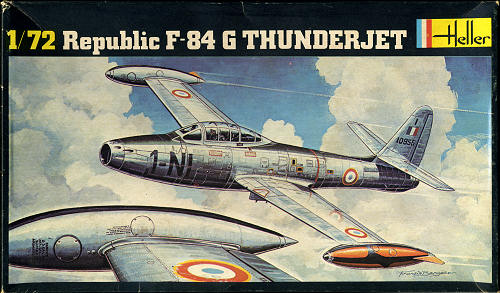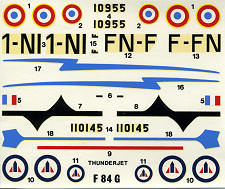
| KIT #: | 278 |
| PRICE: | I paid $2.00 for a started kit |
| DECALS: | Two options |
| REVIEWER: | Scott Van Aken |
| NOTES: | Raised panel lines |

| HISTORY |
The Thunderjet had a distinguished record during the Korean War. Although the F-84B and F-84C could not be deployed because their J35 engines had a service life of only 40 hours, the F-84D and F-84E entered combat with 27th Fighter Escort Group on 7 December 1950. The aircraft were initially tasked with escorting the B-29 Superfortress bombers. The first Thunderjet air-to-air victory was scored on 21 January 1951 at the cost of two F-84s.The F-84 was a generation behind the swept-wing Soviet Mikoyan-Gurevich MiG-15 and outmatched, especially when the MiGs were flown by Soviet pilots, and the MiG counter-air mission was soon given to the F-86 Sabre. Like its famous predecessor, the P-47, the F-84 switched to the low-level interdiction role at which it excelled.
The F-84 flew a total of 86,408 missions, dropping 55,586 tons (50,427 metric tons) of bombs and 6,129 tons (5,560 metric tons) of napalm. The USAF claimed F-84s were responsible for 60% of all ground targets destroyed in the war. Notable F-84 operations included the 1952 attack on the Sui-ho Dam. During the war, the F-84 became the first USAF fighter to utilize aerial refueling. In aerial combat, F-84 pilots were credited with eight MiG-15 kills against a Soviet-claimed loss of 64 aircraft. The total losses were 335 F-84D, E and G models.
| THE KIT |
 For a time in the mid-late 1970s, Heller was really a force with which to be reckoned. In addition to producing kits of some very esoteric (to most) French aircraft, they also produced a number of equally nice 1/72 kits of other planes. Many of these were those that saw some French service and such is the case with the F-84G. For many of us, this was the first decent 1/72 plank wing Thunderjet around.
For a time in the mid-late 1970s, Heller was really a force with which to be reckoned. In addition to producing kits of some very esoteric (to most) French aircraft, they also produced a number of equally nice 1/72 kits of other planes. Many of these were those that saw some French service and such is the case with the F-84G. For many of us, this was the first decent 1/72 plank wing Thunderjet around.  As the kit I used for this was started, and parts layout diagrams were not in vogue at the time, I've used the construction view to show the bits. Yes, it is little more than an exploded view with an added detail diagram. Markings are for two planes. One is French with EC 1 in 1955. Color comes from orange tip tanks. The other is Norwegian with 331 Squadron in 1957. It seems like Heller decals of the time were made yellowed and so it is with this one. I doubt they'd be viable, but one never knows. Fortunately, aftermarket decals are not impossible to find.
As the kit I used for this was started, and parts layout diagrams were not in vogue at the time, I've used the construction view to show the bits. Yes, it is little more than an exploded view with an added detail diagram. Markings are for two planes. One is French with EC 1 in 1955. Color comes from orange tip tanks. The other is Norwegian with 331 Squadron in 1957. It seems like Heller decals of the time were made yellowed and so it is with this one. I doubt they'd be viable, but one never knows. Fortunately, aftermarket decals are not impossible to find. | CONCLUSIONS |
| REFERENCES |
http://en.wikipedia.org/wiki/F-84_Thunderjet
September 2011Thanks to me for this one.
If you would like your product reviewed fairly and fairly quickly, please contact the editor or see other details in the